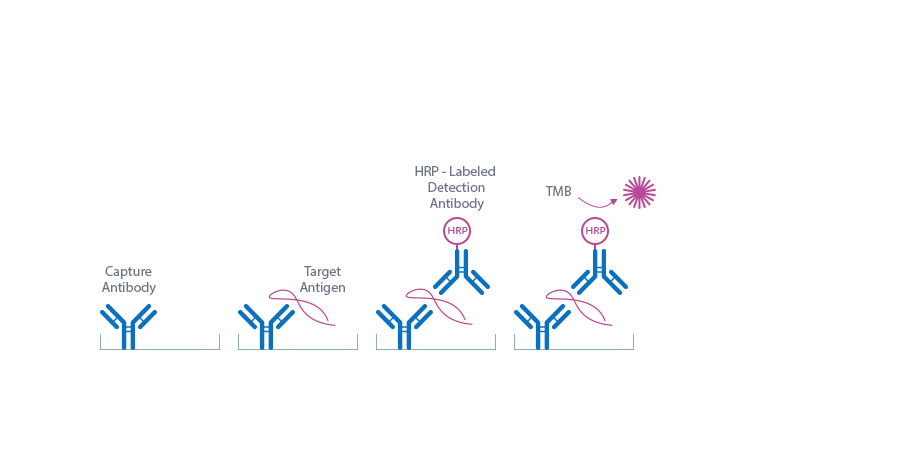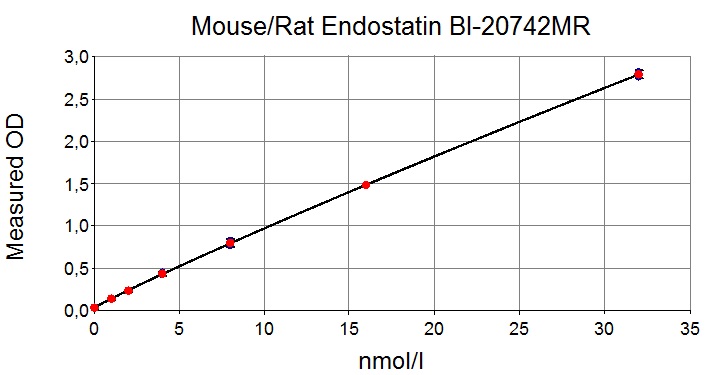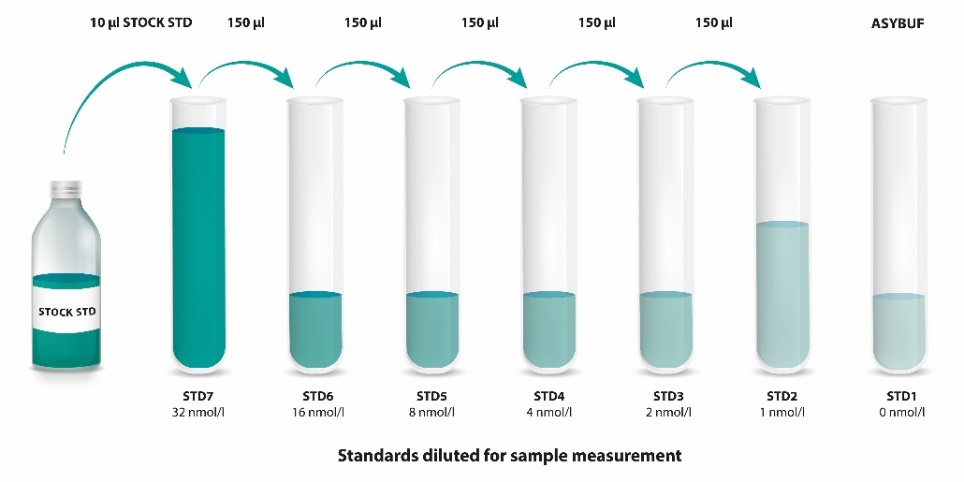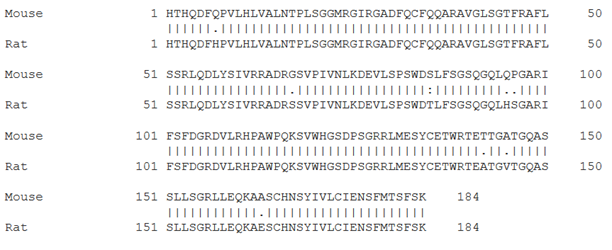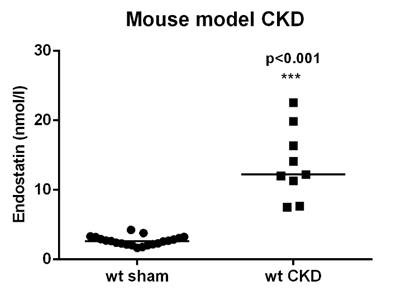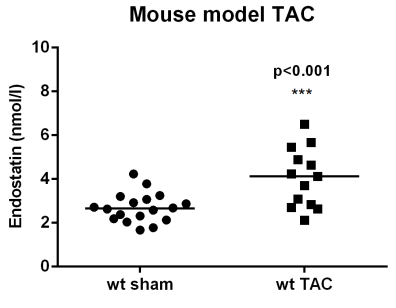Mouse/Rat Endostatin ELISA | BI-20742MR
-
Method
Sandwich ELISA, HRP/TMB, 12×8-well detachable strips
-
Sample type
Mouse/rat serum and plasma
-
Sample volume
5 µl / well
-
Assay time
2 h / 30 min
-
Sensitivity
0.24 nmol/l (= 4.9 ng/ml)
-
Standard range
0 – 32 nmol/l (= 0 – 653 ng/ml)
-
Conversion factor
1 pmol/l = 20.4 pg/ml (MW: 20.4 kDa)
-
Specificity
Endogenous and recombinant mouse and rat Endostatin.
-
Precision
In-between-run (n=15): ≤ 10 % CV
Within-run (n=5): ≤ 9 % CV
-
Cross-reactivity
Endostatin only.
-
Use
Research use only.
-
Validation Data
See validation data tab for: precision, accuracy, dilution linearity, values for healthy donors, etc
-
Synonyms
COL18
Collagen 18
Collagen XVIII
Endostar
Mouse/Rat Endostatin ELISA Product Overview
This Endostatin ELISA kit is a 2.5 hour, 96-well sandwich ELISA for the quantitative determination of Endostatin in mouse and rat serum and plasma.
Mouse/Rat Endostatin ELISA Assay Principle
The mouse/rat Endostatin ELISA kit is a sandwich enzyme immunoassay for the quantitative determination of Endostatin in mouse and rat serum and plasma samples.
The figure below explains the principle of the mouseEndostatin ELISA and rat Endostatin ELISA:
Capture antibody: polyclonal goat anti-mouse Endostatin
Detection antibody: polyclonal goat anti-mouse Endostatin-HRP
Target antigen: mouse/rat Endostatin
In a first step, prediluted standard/control/sample and conjugate (polyclonal goat anti-mouse Endostatin-HRP) are pipetted into the wells of the microtiter strips, which are pre-coated with polyclonal goat anti-mouse Endostatin antibody. Endostatin present in the standard/control/sample binds to the pre-coated antibody in the well and forms a sandwich with the detection antibody in the conjugate. In a washing step all non-specific unbound material is removed. In a second step, the substrate (TMB, tetramethylbenzidine) is pipetted into the wells. The enzyme-catalyzed color change of the substrate is directly proportional to the amount of Endostatin present in the sample. This color change is detectable with a standard microtiter plate reader. A dose response curve of the absorbance (optical density, OD at 450 nm) vs. standard concentration is generated using the values obtained from the standard. The concentration of mouse/rat Endostatin in the sample is determined directly from the dose response curve.
Mouse/Rat Endostatin ELISA Typical Standard Curve
The figure below shows a typical standard curve for the mouse Endostatin ELISA an rat Endostatin ELISA. The immunoassay is calibrated against recombinant Endostatin:
ELISA Kit Components
|
Contents |
Description |
Quantity |
|
PLATE |
Polyclonal goat anti-mouse Endostatin pre-coated microtiter strips in a strip holder, packed in an aluminum bag with desiccant |
12 x 8 tests |
|
WASHBUF |
Wash buffer concentrate 20x, natural cap |
1 x 50 ml |
|
STOCK STD |
Stock standard (32 nmol/l), recombinant mouse Endostatin, red cap, lyophilized |
1 vial |
|
CTRL |
Control, yellow cap, lyophilized, exact concentration see label |
1 vial |
|
ASYBUF |
Assay buffer, red cap, ready to use |
1 x 30 ml |
|
CONJ |
Conjugate, polyclonal goat anti-mouse Endostatin-HRP, amber bottle, amber cap, ready to use |
1 x 7 ml |
|
SUB |
Substrate (TMB solution), amber bottle, blue cap, ready to use |
1 x 13 ml |
|
STOP |
Stop solution, white cap, ready to use |
1 x 7 ml |
Storage instructions: All reagents of the mouse/rat Endostatin ELISA kit are stable at 4°C (2-8°C) until the expiry date stated on the label of each reagent.
Sample Collection & Storage
Serum and plasma are suitable for use in this Endostatin ELISA. We recommend duplicate measurements for all samples, standards and controls. Do not change sample type during studies. The sample collection and storage conditions listed are intended as general guidelines.
Serum & Plasma
Collect venous blood samples in standardized serum separator tubes (SST) or standardized blood collection tubes using EDTA, heparin or citrate as an anticoagulant. For serum samples, allow samples to clot for 30 minutes at room temperature. Perform separation by centrifugation according to the tube manufacturer’s instructions for use. Assay the acquired samples immediately or aliquot and store at -25°C or lower. Lipemic or haemolyzed samples may give erroneous results. Samples are stable for three freeze-thaw cycles
Reagent Preparation
Wash Buffer
|
1. |
Bring the WASHBUF concentrate to room temperature. Crystals in the buffer concentrate will dissolve at room temperature. |
|
2. |
Dilute the WASHBUF concentrate 1:20, e.g. 50 ml WASHBUF + 950 ml distilled or deionized water. Only use diluted WASHBUF when performing the assay. |
The diluted WASHBUF is stable up to one month at 4°C (2-8°C).
Control
|
1. |
Pipette 200 µl of distilled or deionized water into the control (CTRL) vial. The exact concentration is stated on the label of the vial. |
|
2. |
Leave at room temperature (18-26°C) for 15 min. Vortex gently. |
|
3. |
Dilute CTRL 1+50 with ASYBUF (assay buffer) prior to the assay, e.g. 5 µl CTRL + 250 µl ASYBUF (or 10 µl CTRL + 500 µl ASYBUF). |
The reconstituted CTRL is stable at -25°C or lower until expiry date stated on the label and can undergo three freeze-thaw cycles. CTRL diluted 1+50 with ASYBUF should be measured as soon as possible (do not store or freeze).
Note: 50 µl prediluted CTRL is required per well.
Standards
|
1. |
Reconstitute the stock standard (STOCK STD) in 200 µl assay buffer (ASYBUF). Leave at room temperature (18-26°C) for 15 min and mix well before making dilutions. |
|
2. |
Mark tubes STD7 to STD1. Use polypropylene tubes. |
|
3. |
Pipette 500 µl of ASYBUF into the tube marked as STD7. |
|
4. |
Pipette 150 µl of ASYBUF into the tube marked as STD6 to STD1. |
|
5. |
Pipette 10 µl of the reconstituted STOCK STD into tube marked as STD7. Mix thoroughly. |
|
6. |
Prepare a two-fold serial dilution by adding 150 µl of STD7 to STD6. Mix thoroughly. |
|
7. |
ASYBUF serves as the zero standard (STD1, 0 nmol/l Endostatin). |
Reconstituted STOCK STD is stable at -25°C or lower until expiry date on label and can undergo three freeze-thaw cycles.
Note: 50 µl diluted STD is required per well.
Note: The standards prepared according to this protocol already include a 1+50 predilution. Thus, the sample concentrations can be calculated directly from the standard curve without considering the 1+50 dilution of the samples.
Sample Preparation
Bring samples to room temperature and mix samples gently to ensure the samples are homogenous. We recommend duplicate measurements for all samples.
Samples must be diluted 1+50 with ASYBUF (assay buffer), e.g. 5 µl sample + 250 µl ASYBUF (or 10 µl sample + 500 µl ASYBUF). Diluted samples for which the OD value exceeds the highest point of the standard range can be further diluted with ASYBUF (assay buffer). Prediluted samples should be measured as soon as possible (do not store or freeze).
Note: 50 μl prediluted sample is required per well.
Mouse/Rat Endostatin ELISA Assay Protocol
Read the entire protocol before beginning the assay.
|
1. |
Bring samples and reagents to room temperature (18-26°C). |
|
2. |
Mark positions for STD/CTRL/SAMPLE (standard/control/sample) on the protocol sheet. |
|
3. |
Take microtiter strips out of the aluminum bag. Store unused strips with desiccant at 4°C in the aluminum bag. Strips are stable until expiry date stated on the label. |
|
4. |
Pipette 50 µl STD/CTRL/SAMPLE into the respective wells. |
|
5. |
Add 50 µl CONJ (conjugate, amber cap) into each well. Swirl gently. |
|
6. |
Cover the plate tightly and incubate for 2 hours at room temperature 4°C (2-8°C). |
|
7. |
Aspirate and wash wells 5 x with 300 µl diluted WASHBUF (wash buffer). After the final wash, remove the remaining WASHBUF by strongly tapping plate against a paper towel. |
|
8. |
Add 100 µl SUB (substrate, blue cap) into each well. |
|
9. |
Incubate for 30 min at room temperature in the dark. |
|
10. |
Add 50 µl STOP (stop solution, white cap) into each well. |
|
11. |
Measure absorbance immediately at 450 nm with reference 630 nm, if available. |
Calculation of Results
Construct a standard curve from the absorbance read-outs of the standards using commercially available software capable of generating a four-parameter logistic (4-PL) fit. Alternatively, plot the standards’ concentration on the x-axis against the mean absorbance for each standard on the y-axis and draw a best fit curve through the points on the graph. Curve fitting algorithms other than 4-PL have not been validated and will need to be evaluated by the user.
Obtain sample concentrations from the standard curve. If required, nmol/l can be converted into ng/ml by applying a conversion factor (1 ng/ml =0.049 nmol/l (MW: 20.4 kDa)). Since standards/controls/samples are all diluted 1+50 prior to the assay, sample concentrations can be calculated directly from the standard curve. Sample dilution factors other that 1+50 have to be considered when calculating the final concentration of the sample.
The quality control (QC) protocol supplied with the kit shows the results of the final release QC for each kit lot. Data for OD obtained by customers may differ due to various influences including the normal decrease of signal intensity thorughout shelf life. However, this does not affect validity of results as long as an OD of 1.00 or more is obtained for the STD with the highest concentration and the value of the CTRL is within the target range (see labels).
Endostatin Protein
Endostatin, a 20-kDa C-terminal proteolytic fragment of collagen XVIII, is an endogenous angiogenesis inhibitor localized in the vascular basement membrane in various organs (http://www.uniprot.org/uniprot/P39060). The biological functions of the Endostatin-network involve SPARC, thrombospondin-1, glycosaminoglycans, collagens, and integrins.
|
Molecular weight |
20 kDa |
|
Cellular localisation |
Extracellular |
|
Post-translational modifications |
Proteolytic processing, glycosylation, hydroxylation |
|
Sequence similarities |
Member of the collagen familiy |
|
Alternative names |
- |
|
Pubchem ID |
187888 link: https://pubchem.ncbi.nlm.nih.gov/compound/Endostatin |
|
Genecards |
COL18A1 link: https://www.genecards.org/cgi-bin/carddisp.pl?gene=COL18A1 |
|
OMIM |
120328 link: https://www.omim.org/entry/120328 |
|
PDB |
1KOE link: http://www.rcsb.org/structure/1KOE |
|
Pfam |
PF06482 link: http://pfam.xfam.org/family/endostatin |
|
Protein Atlas |
COL18A1 link: https://www.proteinatlas.org/ENSG00000182871-COL18A1/tissue |
|
Uniprot ID |
P39060 (COIA1_HUMAN) link: https://www.uniprot.org/uniprot/P39060 |
Endostatin Function
In animal studies, renal Edostatin expression preceded deteriorating kidney function and induced renal fibrosis in aging mice. In humans, Endostatin is expressed during the progression of renal fibrosis in tubular cells of injured tissue. In renal micro-vascular disease, observed in late stages of patients with chronic kidney disease, increased Endostatin levels are possibly the consequence of enhanced extracellular matrix degradation. Thus Endostatin may become an important marker for progressive microvascular renal disease in patients with chronic kidney disease. Endostatin levels in blood are also likely to increase in patients with other microvascular tissue injuries, including atherosclerosis, myocardial- and brain ischemia. In ischemic stroke patients, high Endostatin plasma levels predict a worse long-term clinical outcome. In a cohort of critically ill patients, plasma Endostatin improved AKI prediction based on clinical risk factors. Endostatin has evolved as a molecular target and is currently under investigation in clinical trials.
-
Angiogenesis in Cancer
-
Bladder cancer
-
Gastric cancer
-
Breast cancer
-
Cervical cancer
-
Lung cancer
-
Acute myeloid leukaemia
-
Oral squamous cancer
-
-
Cardiovascular Disease
-
Stroke
-
Microvascular injury
-
Coronary artery disease
-
Diabetes mellitus
-
Hypertension
-
Heart failure
-
-
Kidney Disease
-
Chronic kidney disease
-
Renal fibrosis
-
-
Endostatin expression in the murine model of ischaemia/reperfusion-induced acute renal failure.
Bellini MH et al., Nephrology 2007; 12(5):459–65.
-
Endostatin and kidney fibrosis in aging: a case for antagonistic pleiotropy?
Lin CHS et al., Am J Physiol Heart Circ Physiol 2014; 306:H1692–9.
-
Plasma endostatin may improve acute kidney injury risk prediction in critically ill patients.
Mårtensson J et al., Ann Intensive Care 2016; 6:6.
-
Endostatin in chronic kidney disease: Associations with inflammation, vascular abnormalities, cardiovascular events and survival.
Kanbay et al., European Journal of Internal Medicine 2016; 63: 81-87.
-
The association between endostatin and kidney disease and mortality in patients with type 2 diabetes.
Carlsson AC et al., Diabetes & Metabolism 2016 ; 42(5) 351-357.
-
Elevated plasma levels of endostatin are associated with chronic kidney disease.
Chen et al., Am J Nephrol 2012; 35(4): 335-340.
-
Early-onset coronary artery disease after pediatric kidney transplantation: implicating the angiogenesis inhibitor, endostatin.
Igbal CW et al., Am Surg 2011; 77(6): 731-735.
-
A large screening of angiogenesis biomarkers and their association with neurological outcome after ischemic stroke.
Navarro-Sobrino M et al., Atherosclerosis 2011; 16(1): 205-211.
Calibration
The mouse/rat Endostatin immunoassay is calibrated against purified recombinant mouse Endostatin peptide.
Mouse/Rat Endostatin ELISA Detection Limit & Sensitivity
To determine the sensitivity of the mouse/rat Endostatin ELISA, experiments measuring the lower limit of detection (LOD) and the lower limit of quantification (LLOQ) were conducted.
The LOD, also called the detection limit, is the lowest point at which a signal can be distinguished above the background signal, i.e. the signal that is measured in the absence of Endostatin, with a confidence level of 99%. It is defined as the mean back calculated concentration of Endostatin-free sample (three independent measurements) plus three times the standard deviation of the measurements.
The LLOQ, or sensitivity of an assay, is the lowest concentration at which an analyte can be accurately quantified. The criteria for accurate quantification at the LLOQ are an analyte recovery between 75 and 125% and a coefficient of variation (CV) of less than 25%. The lowest sample concentration of Endostatin, which meets both criteria, is reported as the LLOQ.
The following values were determined for the mouse/rat Endostatin ELISA:
|
LOD |
0.24 nmol/l |
| LLOQ | 0.5 nmol/l |
Mouse/Rat Endostatin ELISA Precision
The precision of an ELISA is defined as its ability to measure the same concentration consistently within the same experiments carried out by one operator (within-run precision or repeatability) and across several experiments using the same samples but conducted by several operators at different locations using different ELISA lots (in-between-run precision or reproducibility).
Within-Run Precision
Within-run precision was tested by measuring the same samples 5 times within one mouse/rat Endostatin ELISA lot. The experiment was conducted by one operator.
|
ID |
n |
Mean Endostatin [nmol/l] |
SD [nmol/l] |
CV [%] |
|
Sample 1 |
5 |
0.98 |
0.09 |
9 |
|
Sample 2 |
5 |
31.98 |
0.55 |
2 |
In-Between-Run Precision
In-between-run precision was assessed by measuring the same samples 15 times within multiple mouse/rat Endostatin ELISA lot. The measurements were carried out by multiple operators.
|
ID |
n |
Mean Endostatin [nmol/l] |
SD [nmol/l] |
CV [%] |
|
Sample 1 |
15 |
1.01 |
0.10 |
10 |
|
Sample 2 |
15 |
31.99 |
0.48 |
2 |
Mouse/Rat Endostatin ELISA Accuracy
The accuracy of an ELISA is defined as the precision with which it can recover samples of known concentrations.
The recovery of the mouse/rat Endostatin ELISA was measured by adding recombinant Endostatin to mouse/rat samples containing a known concentration endogenous Endostatin. The % recovery of the spiked concentration was calculated as the percentage of measured compared over the expected value.
These tables show the summary of the recovery experiments in the mouse/rat Endostatin ELISA in different sample matrices:
|
% Recovery |
|||||
|
Sample matrix |
n |
+8 nmol/l |
+25 nmol/l |
||
|
Mean |
Range |
Mean |
Range |
||
|
Mouse serum |
5 |
97 |
86 - 112 |
95 |
85 - 111 |
|
Mouse plasma |
5 |
85 |
78 - 89 |
91 |
83 - 96 |
|
% Recovery |
|||||
|
Sample matrix |
n |
+7.4 nmol/l |
+22 nmol/l |
||
|
Mean |
Range |
Mean |
Range |
||
|
Rat serum |
4 |
83 |
78 - 95 |
97 |
95 - 100 |
Data showing recovery of Endostatin in mouse serum samples:
|
Endostatin [nmol/l] |
% Recovery |
|||||
|
Sample matrix |
ID |
Reference |
+8 nmol/l |
+25 nmol/l |
+8 nmol/l |
+25 nmol/l |
|
Mouse serum |
s1 |
3.63 |
11.19 |
30.38 |
98 |
111 |
|
Mouse serum |
s2 |
3.01 |
10.35 |
25.34 |
95 |
93 |
|
Mouse serum |
s3 |
3.30 |
12.01 |
27.35 |
112 |
100 |
|
Mouse serum |
s4 |
2.78 |
9.75 |
24.37 |
90 |
89 |
|
Mouse serum |
s5 |
3.49 |
10.72 |
26.02 |
94 |
94 |
|
Mouse serum |
s6 |
2.49 |
9.18 |
23.13 |
86 |
85 |
|
Mouse serum |
s7 |
9.14 |
16.66 |
29.74 |
103 |
92 |
|
|
|
|
|
Mean |
97 |
95 |
|
|
|
|
|
Min |
86 |
85 |
|
|
|
|
|
Max |
112 |
111 |
Data showing recovery of Endostatin in mouse plasma samples:
|
Endostatin [nmol/l] |
% Recovery |
|||||
|
Sample matrix |
ID |
Reference |
+8 nmol/l |
+25 nmol/l |
+8 nmol/l |
+25 nmol/l |
|
Mouse plasma |
e1 |
1.99 |
8.64 |
24.50 |
85 |
92 |
|
Mouse plasma |
e2 |
1.64 |
8.24 |
25.12 |
84 |
96 |
|
Mouse plasma |
e3 |
1.65 |
8.49 |
21.96 |
87 |
83 |
|
Mouse plasma |
e4 |
1.50 |
8.46 |
24.38 |
89 |
93 |
|
Mouse plasma |
e5 |
2.37 |
8.41 |
24.05 |
78 |
89 |
|
Mean |
85 |
91 |
||||
|
Min |
78 |
83 |
||||
|
Max |
89 |
96 |
||||
Data showing recovery of Endostatin in a rat serum sample:
|
Endostatin [nmol/l] |
% Recovery |
|||||
|
Sample matrix |
ID |
Reference |
+7.4 nmol/l |
+22 nmol/l |
+7.4 nmol/l |
+22 nmol/l |
|
Rat serum |
s1 |
2.90 |
8.8 |
23.80 |
80 |
95 |
|
Rat serum |
s2 |
4.10 |
10.1 |
25.10 |
81 |
95 |
|
Rat serum |
s3 |
3.40 |
10.4 |
25.50 |
95 |
100 |
|
Rat serum |
s4 |
2.10 |
7.9 |
23.60 |
78 |
98 |
|
Mean |
83 |
97 |
||||
|
Min |
78 |
95 |
||||
|
Max |
95 |
100 |
||||
Mouse/Rat Endostatin ELISA Dilution Linearity & Paralellism
Tests of dilution linearity and parallelism ensure that both endogenous and recombinant samples containing Endostatin behave in a dose dependent manner and are not affected by matrix effects. Dilution linearity assesses the accuracy of measurements in diluted mouse/rat samples spiked with known concentrations of recombinant analyte. By contrast, parallelism refers to dilution linearity in mouse/rat samples and provides evidence that the endogenous analyte behaves the same way as the recombinant one. Dilution linearity and parallelism are assessed for each sample type and are considered good if the results are within 20% of the expected concentration.
Dilution linearity was assessed by serially diluting mouse/rat mouse and rat samples spiked with 22 nmol/l and 25 nmol/l recombinant mouse Endostatin respectively with assay buffer.
The table below shows the mean recovery and range of serially diluted recombinant Endostatin in several sample matrices:
|
% Recovery of recombinant Endostatin in diluted samples |
|||||||
|
Sample matrix |
n |
1+1 |
1+3 |
1+7 |
|||
|
Mean |
Range |
Mean |
Range |
Mean |
Range |
||
|
Mouse serum |
7 |
108 |
103 - 119 |
117 |
107 - 130 |
114 |
108 - 124 |
|
Mouse plasma |
6 |
101 |
96 - 113 |
103 |
101 - 105 |
103 |
95 - 107 |
|
Rat serum |
5 |
99 |
978 - 108 |
||||
Data showing dilution linearity of 25 nmol/l recombinant Endostatin spiked into mouse blood samples (reference) containing endogenous Endostatin:
|
Endostatin [nmol/l] |
% Recovery |
|||||||
|
Sample matrix |
ID |
Reference |
1+1 |
1+3 |
1+7 |
1+1 |
1+3 |
1+7 |
|
Mouse serum |
s1 |
30.09 |
17.84 |
9.77 |
4.27 |
119 |
130 |
114 |
|
Mouse serum |
s2 |
33.82 |
17.81 |
9.06 |
4.57 |
105 |
107 |
108 |
|
Mouse serum |
s3 |
30.56 |
16.51 |
8.65 |
4.41 |
108 |
113 |
115 |
|
Mouse serum |
s4 |
29.63 |
15.55 |
8.78 |
3.99 |
105 |
119 |
108 |
|
Mouse serum |
s5 |
28.98 |
15.41 |
8.41 |
4.49 |
106 |
116 |
124 |
|
Mouse serum |
s6 |
28.85 |
15.95 |
8.55 |
4.22 |
111 |
119 |
117 |
|
Mouse serum |
s7 |
30.11 |
15.49 |
8.65 |
4.13 |
103 |
115 |
110 |
|
Mean |
108 |
117 |
114 |
|||||
|
Min |
103 |
107 |
108 |
|||||
|
Max |
119 |
130 |
124 |
|||||
|
Endostatin [nmol/l] |
% Recovery |
|||||||
|
Sample Matrix |
ID |
Reference |
1+1 |
1+3 |
1+7 |
1+1 |
1+3 |
1+7 |
|
Mouse plasma |
p1 |
24.50 |
12.17 |
6.38 |
3.28 |
99 |
105 |
103 |
|
Mouse plasma |
p2 |
25.12 |
12.06 |
6.12 |
3.14 |
96 |
101 |
103 |
|
Mouse plasma |
p3 |
21.96 |
12.39 |
6.39 |
3.42 |
113 |
103 |
107 |
|
Mouse plasma |
p4 |
24.38 |
11.94 |
6.15 |
2.93 |
98 |
103 |
95 |
|
Mouse plasma |
p5 |
24.05 |
12.24 |
6.19 |
3.25 |
102 |
101 |
105 |
|
Mean |
101 |
103 |
103 |
|||||
|
Min |
96 |
101 |
95 |
|||||
|
Max |
113 |
105 |
107 |
|||||
Data showing dilution linearity of 22 nmol/l recombinant Endostatin spiked into rat blood samples (reference) containing endogenous Endostatin:
|
Endostatin [nmol/l] |
% Recovery |
|||
|
Sample matrix |
ID |
Reference |
1+1 |
1+1 |
|
Rat serum |
s1 |
23.80 |
11.10 |
93 |
|
Rat serum |
s2 |
25.10 |
11.60 |
92 |
|
Rat serum |
s3 |
25.50 |
12.70 |
100 |
|
Rat serum |
s4 |
23.60 |
11.00 |
93 |
|
Rat serum |
s5 |
15.30 |
8.30 |
108 |
|
Rat serum |
s6 |
16.30 |
8.60 |
106 |
|
Rat serum |
s7 |
19.00 |
7.40 |
78 |
|
Mean |
99 |
|||
|
Min |
92 |
|||
|
Max |
119 |
|||
Parallelism was assessed by serially diluting mouse/rat samples containing endogenous Endostatin with assay buffer.
The table below shows the mean recovery and range of serially diluted endogenous Endostatin in several mouse and rat sample matrices:
|
% Recovery of endogenous Endostatin in diluted samples |
|||||
|
Sample matrix |
n |
1+1 |
1+3 |
||
|
Mean |
Range |
Mean |
Range |
||
|
Mouse serum |
7 |
101 |
95 - 112 |
88 |
75 - 96 |
|
Mouse plasma |
6 |
107 |
94 - 114 |
109 |
85 - 133 |
|
Rat serum |
5 |
96 |
89 - 105 |
89 |
78 - 105 |
|
Rat plasma |
6 |
89 |
80 - 95 |
80 |
75 - 89 |
Data showing dilution linearity of endogenous Endostatin in mouse serum samples:
|
Endostatin [nmol/l] |
% Recovery |
|||||
|
Sample matrix |
ID |
Reference |
1+1 |
1+3 |
1+1 |
1+3 |
|
Mouse serum |
s1 |
3.79 |
1.90 |
0.71 |
100 |
75 |
|
Mouse serum |
s2 |
4.74 |
2.32 |
1.09 |
98 |
92 |
|
Mouse serum |
s3 |
4.22 |
2.19 |
0.92 |
104 |
87 |
|
Mouse serum |
s4 |
3.94 |
1.94 |
0.90 |
98 |
91 |
|
Mouse serum |
s5 |
2.68 |
1.50 |
0.64 |
112 |
96 |
|
Mouse serum |
s6 |
5.01 |
2.39 |
1.13 |
95 |
90 |
|
Mean |
101 |
88 |
||||
|
Min |
95 |
75 |
||||
|
Max |
112 |
96 |
||||
Data showing dilution linearity of endogenous Endostatin in mouse plasma samples:
|
Endostatin [nmol/l] |
% Recovery |
|||||
|
Sample matrix |
ID |
Reference |
1+1 |
1+3 |
1+1 |
1+3 |
|
Mouse plasma |
p1 |
5.52 |
2.59 |
1.42 |
94 |
103 |
|
Mouse plasma |
p2 |
5.43 |
2.79 |
1.47 |
103 |
108 |
|
Mouse plasma |
p3 |
1.99 |
1.08 |
0.66 |
109 |
133 |
|
Mouse plasma |
p4 |
1.65 |
0.92 |
0.43 |
112 |
104 |
|
Mouse plasma |
p5 |
1.50 |
0.84 |
0.32 |
112 |
85 |
|
Mouse plasma |
p6 |
2.37 |
1.35 |
0.73 |
114 |
123 |
|
Mean |
107 |
109 |
||||
|
Min |
94 |
85 |
||||
|
Max |
114 |
133 |
||||
Data showing dilution linearity of endogenous Endostatin in rat serum samples:
|
Endostatin [nmol/l] |
% Recovery |
|||||
|
Sample matrix |
ID |
Reference |
1+1 |
1+3 |
1+1 |
1+3 |
|
Rat serum |
s1 |
2.37 |
1.2 |
0.6 |
101 |
94 |
|
Rat serum |
s2 |
2.39 |
1.1 |
0.6 |
92 |
99 |
|
Rat serum |
s3 |
1.81 |
0.8 |
0.4 |
89 |
78 |
|
Rat serum |
s4 |
2.34 |
1.1 |
0.5 |
97 |
83 |
|
Rat serum |
s5 |
2.35 |
1.2 |
0.6 |
100 |
105 |
|
Rat serum |
s6 |
2.23 |
1.1 |
0.6 |
94 |
100 |
|
Rat serum |
s7 |
2.32 |
1.2 |
0.5 |
102 |
91 |
|
Mean |
96 |
89 |
||||
|
Min |
89 |
78 |
||||
|
Max |
102 |
105 |
||||
[/table]
Data showing dilution linearity of endogenous Endostatin in rat plasma samples:
|
Endostatin [nmol/l] |
% Recovery |
|||||||
|
Sample matrix |
ID |
Reference |
1+1 |
1+3 |
1+7 |
1+1 |
1+3 |
1+7 |
|
Rat plasma |
p1 |
3.4 |
1.6 |
1.0 |
0.5 |
93 |
89 |
75 |
|
Rat plasma |
p2 |
2.9 |
1.4 |
0.8 |
0.5 |
95 |
78 |
90 |
|
Rat plasma |
p3 |
3.4 |
1.4 |
0.9 |
0.4 |
80 |
75 |
54 |
|
Rat plasma |
p4 |
3.3 |
1.5 |
0.8 |
0.4 |
89 |
77 |
62 |
|
Mean |
89 |
80 |
71 |
|||||
|
Min |
80 |
75 |
62 |
|||||
|
Max |
95 |
89 |
90 |
|||||
Mouse/Rat Endostatin ELISA Specificity
The specificity of an ELISA is defined as its ability to exclusively recognize an analyte, which means that the ELISA antibodies will bind to the target analyte while not binding to other molecules in solution.
The specificity of the ELISA was established through competition experiments, which measure the ability of the antibodies to exclusively bind Endostatin.
Competition of Signal
Competition experiments were carried out by pre-incubating mouse/rat samples with an excess of coating antibody. The concentration measured in this mixture was then compared to a reference value, which was obtained from the same sample but without the pre-incubation step. If competition is successful, Endostatin is expected to be competed out by the added capture antibody.
The competition was performed by adding a 10-fold concentration of the capture antibody compared to the analyte.
Competition of mouse serum samples containing endogenous mouse Endostatin was observed as follows:
|
Endostatin [nmol/l] |
||||
|
Sample matrix |
ID |
Reference |
Reference + anti-Endostatin antibody |
% Competition |
|
Mouse serum |
s1 |
4.02 |
0.00 |
100 |
|
Mouse serum |
s2 |
3.79 |
0.00 |
100 |
|
Mouse serum |
s3 |
4.74 |
0.00 |
100 |
|
Mouse serum |
s4 |
4.22 |
0.00 |
100 |
|
Mouse serum |
s5 |
3.41 |
0.00 |
100 |
|
Mouse serum |
s6 |
3.94 |
0.00 |
100 |
|
Mouse serum |
s7 |
2.68 |
0.00 |
100 |
|
Mouse serum |
s8 |
5.01 |
0.00 |
100 |
|
Mean |
100 |
|||
Competition of mouse plasma samples containing endogenous mouse Endostatin was observed as follows:
|
Endostatin [nmol/l] |
||||
|
Sample matrix |
ID |
Reference |
Reference + anti-Endostatin antibody |
% Competition |
|
Mouse plasma |
p1 |
3.1 |
0.0 |
100 |
|
Mouse plasma |
p2 |
5.5 |
0.3 |
95 |
|
Mouse plasma |
p3 |
5.4 |
0.3 |
95 |
|
Mouse plasma |
p4 |
2.0 |
0.1 |
97 |
|
Mouse plasma |
p5 |
1.6 |
0.0 |
100 |
|
Mouse plasma |
p6 |
1.7 |
0.0 |
99 |
|
Mouse plasma |
p7 |
1.5 |
0.0 |
100 |
|
Mouse plasma |
p8 |
2.4 |
0.1 |
96 |
|
Mean |
98 |
|||
Competition of rat serum samples containing endogenous mouse Endostatin was observed as follows:
|
Endostatin [nmol/l] |
||||
|
Sample matrix |
ID |
Reference |
Reference + anti-Endostatin antibody |
% Competition |
|
Rat serum |
s1 |
2.4 |
0.00 |
100 |
|
Rat serum |
s2 |
1.8 |
0.00 |
100 |
|
Rat serum |
s3 |
2.3 |
0.00 |
100 |
|
Rat serum |
s4 |
2.3 |
0.00 |
100 |
|
Rat serum |
s5 |
2.2 |
0.00 |
100 |
|
Mean |
100 |
|||
Homology of Mouse and Rat Endostatin
Homology of mouse and rat Endostatin is estimated to be 95.7%.
The antibodies utilized in this assay are both polyclonal antibodies that detect various regions of the Endostatin molecule.
Sample Stability
We recommend separating plasma or serum by centrifugation as soon as possible, e.g. 20 min at 2,000 x g, preferably at 4°C (2-8°C). Samples can be stored at 4°C (2-8°C) overnight. For long term storage, aliquot the acquired plasma or serum samples and store at -25°C or lower.
The stability of endogenous Endostatin was tested by comparing Endostatin measurements in samples that had undergone four freeze-thaw cycles.
For freeze-thaw experiments, samples were collected according to the supplier’s instruction using blood collection devices and stored at -80°C. Reference samples were freeze-thawed once. The mean recovery of sample concentration after four freeze-thaw cycles is 94%.
|
Endostatin [nmol/l] |
% Recovery after 4 freeze/thaw cycles |
|||
|
ID |
2x |
3x |
4x |
|
|
1 |
4.0 |
4.2 |
4.0 |
99 |
|
2 |
3.6 |
3.7 |
3.0 |
82 |
|
3 |
4.5 |
4.5 |
3.9 |
87 |
|
4 |
4.1 |
4.1 |
3.7 |
92 |
|
5 |
3.2 |
3.5 |
3.0 |
92 |
|
6 |
3.3 |
3.3 |
3.2 |
99 |
|
7 |
4.6 |
5.3 |
4.8 |
104 |
|
Mean |
94 |
|||
Samples can be subjected to four freeze-thaw cycles.
Sample Values
To provide expected values for circulating Endostatin, a panel of samples from apparently healthy animals was tested.
A summary of the results is shown below:
|
Samples |
Age, gender |
n |
Endostatin [nmol/l] |
|
Mouse sera (C57BL6JOlaHsd) controls |
12 wks |
11 |
6.7 ± 0.8 |
|
Wildtype mouse sera normal values |
12 wks, female |
10 |
4.1 ± 0.6 |
|
Wildtype mouse sera normal values |
12 wks, male |
10 |
5.4 ± 1.2 |
|
Wildtype rat sera normal values |
12 wks, male |
8 |
2.5 ± 0.4 |
We recommended establishing the normal range for each laboratory.
Endostatin Values in a CKD and TAC panel
In addition to samples from apparently healthy donors, a panel of samples from CKD model mice was tested.
Mean Endostatin serum values from wildtype normal mice. Age: 6 months, male (n= 21): 2.6 ± 0.4 nmol/l
Mean Endostatin serum values from wildtype CKD mice. Age: 6 months, male (n= 9): 14.0 ± 1.74 nmol/ml.
Mean Endostatin serum values from wildtype normal mice. Age: 6 months, male (n= 21): 2.6 ± 0.4 nmol/l
Mean Endostatin serum values from wildtype CKD mice. Age: 6 months, male (n= 9): 14.0 ± 1.74 nmol/ml.
- Validation of an enzyme-linked immunosorbent assay (ELISA) for quantification of endostatin levels in mice as a biomarker of developing glomerulonephritis.
Wallwitz, J., Aigner, P., Gadermaier, E., Bauer, E., Casanova, E., Bauer, A., Stoiber, D., 2019. PLoS ONE 14, e0220935.
PMID:31404120; PMCID: PMC6690585
-
ISN Frontiers poster #P-466, Tokyo February 2018
 Download biomedica product list
Download biomedica product list



